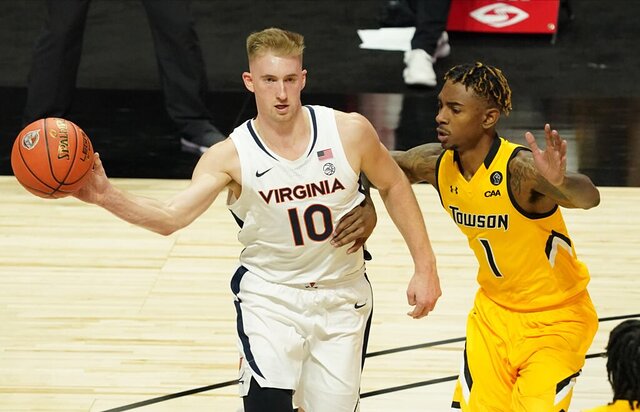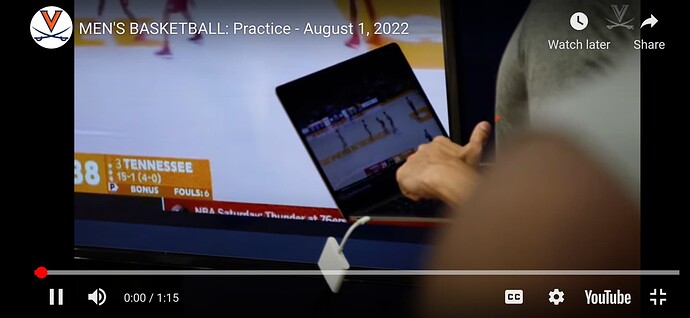Unfortunately I will be a few hundred miles from cville for the foreseeable future but best of luck ![]()
The 5-out we ran briefly a couple years ago had no ball screen, which I thought was interesting. In the one clip that’s made out for public consumption, there is a ball screen element. Something to keep on.
I usually don’t post articles behind a paywall, but Eamonn had a pretty good write up of the 5 out offense we ran briefly a couple of years ago. I still wonder what woukd things look like if we had blown out SF?
Is Virginia experimenting with an offense created in Division III? Looks like it
What, exactly, was Virginia running? That was the college hoops Twitter question of the day on Black Friday, as the Cavaliers scuffled their way through a Bubbleville matchup with a San Fransisco team coming off a season-opening loss to UMass-Lowell, a team Virginia was prohibitively favored to beat. The Dons were undoubtedly guarding Virginia well; they were making everything difficult, everything challenged.
Yet there was also a strange, stagnant, unrecognizable quality to a Virginia offense that had destroyed Towson, 89-54, two days prior. Were those — gasp — iso plays Tony Bennett was running for star redshirt senior Sam Hauser, the wing scoring force who was supposed to elevate Virginia’s rock-chewing offense of a season ago into something more functional, if not elegant, in 2020-21? Why were so many guys making uncertain cuts? Why were so many standing around? Where was the blocker-mover, that Bennett family staple, an immediately recognizable pattern of constant offensive motion? Where was the ball-screen continuity, the great innovation of Virginia’s national title season? Had this revamped but experienced team, faced with a smack in the mouth, just plumb lost its structure altogether? What, exactly, was Virginia running?
Turns out, it was a new offense altogether, one even the most obsessed college hoops fans watching that day almost certainly hadn’t seen.
Indeed, Virginia was experimenting with a wholesale change in the way it approached offensive basketball. The system Bennett had installed — a free-flowing read-and-react style that prioritizes positionless play and the intuitive decision-making of the players on the floor — is the brainchild of Noah Laroche, the owner of Integrity Hoops, an NBA developmental consultancy that has worked with Blake Griffin, Russell Westbrook, and other professional basketball players. Laroche is a former Division III player at St. Joseph’s of Maine. After hitting a low offensive point, Laroche’s coach, Rob Sanicola, asked his former player to help him install an entirely new offense. In 2018-19, the first full year of the offense’s installation, St. Joseph’s averaged 93 points per game, more than 20 per game more than it had the season before.
Coach Daniel, a YouTube creator, made a series of 2019 videos about the St. Joseph’s system, the first of which was titled, “Why NBA Teams Should Study A School You’ve Never Heard Of.” As Daniel describes, the offense features “no set plays, no pick-and-rolls, no dribble handoffs, and no patterned offenses” — any of which alone would have made it somewhat revolutionary, given the near-universal adoption of those types of plays at all levels of the sport in 2020. Instead, the offense governs itself by a set of broad principles. All five players are frequently spaced around the 3-point line, leaving the interior area of the floor wide open, with the occasional odd-looking “post” player spaced in the short corner not far from a teammate. Players do not cross paths in conventional ways, but move around to maintain healthy spacing. All five players truly are positionless, to the point the defensive rebounder is expected to bring the ball up the floor. Any pass is always immediately followed by a cut.
It all sounds simple, and it is, but the learning curve is not insignificant: The offense requires a high level of understanding for five players to implement on the court in a way that ultimately flows. In a Jan. 10, 2019 Portland Press Herald story, St. Joseph’s players talked about how hard the offense was to master at first, until they eventually clicked. “We weren’t used to how to get the best shot in the offense,” sophomore Jack Castle told the paper. “But it really isn’t an offense.” Once St. Joseph’s reached that level of intuition, the results could look downright radical.
It’s not hard to see why Bennett and his staff were drawn to the scheme. (And it is, by the way, it was easy to see why teams in the modern NBA would want to apply its principles.) After fielding the least efficient offensive team in a decade-plus at UVa, one that felt like an old-school slog stereotype of everything people used to (incorrectly) say about Virginia basketball, Bennett arrived at the 2020-21 season suddenly in possession of one of the more versatile, outside-in rosters in college hoops. The team’s starting center, Jay Huff, is a mobile 7-footer who is a career 39 percent shooter from 3. Its four, Hauser, is one of the best pure perimeter scorers in the sport. “Those guys can both really stretch the floor,” Bennett said in the fall. “They’re a very unique thing.” Ditto Trey Murphy, a sharpshooting 6-foot-9 Rice transfer, who was suddenly eligible due to the pandemic, and could play a number of spots, alongside guards and wings Tomas Woldetensae, Casey Morsell, Justin McKoy and even Kihei Clark, who despite his size is comfortable operating on the dribble around the rim. This was arguably the least conventional, most positionally flexible roster of Bennett’s time at Virginia; if not now, then when? Besides, the last time Bennett added a new offensive system to UVa’s mix, he won a national title.
The problem, of course, is that such adaptation takes time. This was hardly the ideal offseason in which to overhaul your offensive philosophy; everyone started practice later than usual, in more individualized settings than normal, with no exhibition games to work out the kinks. Besides, Bennett’s staff is always focused foremost on ensuring that its trademark pack-line defense is drilled into the players before anything else.
Hauser is averaging 14.5 points per game this season. (David Butler II / USA Today)
Against Towson, and especially San Fransisco, Virginia’s new offense was fully evident. The Hoos still ran their old stuff, but there were huge stretches of possessions without ball screens, where Huff would hover around the wing much as any guard would, when multiple cutters would flash in multiple directions, everyone playing off feel. There were some good possessions here and there, like this Clark mid-post touch and this pop-out Murphy 3, (both of which were cut by Hoop Vision’s Jordan Sperber). More often, though, the cuts were made with a lack of certainty, and players — oftentimes Hauser, especially down the stretch — got caught isolated in the inefficient mid-post area with the ball in their hands and a contested 2 needing to go up before the shot clock ended.
After the loss to the Dons, in which Virginia scored just 60 points in 62 possessions, Bennett was mostly focused, as per, on his team’s defense, on his belief his players needed to dig out more stops down the stretch to secure the game. But the offensive, he acknowledged, wasn’t ideal either. “We weren’t great, that’s for sure,” he said. “And the stats back it up.”
Five nights later, Virginia’s offense was much better. It was also back to its old stylistic self. The Cavaliers scored 76 points in 62 possessions against St. Francis, the vast majority of which came by way of the good ol’ Bennett-invented blocker-mover O, particularly in the first half.
The same retrenchment appeared to be playing out last Friday, in Virginia’s home overtime win over Kent State. The Hoos began the game in the classic blocker-mover and ran that and ball-screen continuity throughout the first half. Viewed again in snippets on Synergy, charting Virginia’s offensive possessions, an exercise that began eagerly, pen in hand, quickly turned into a simple matter of writing “no” every time the Cavaliers initiated their half-court offense. The five-out, read-react stuff was nowhere to be found.
And then in the second half, there it was. After a series of possessions in which Kent State’s scrappy, well-prepared players shut down Virginia’s conventional stuff, at the 11:04 mark the five-out offense showed up in force. And it mostly worked. Suddenly, the ball screens and fade screens were gone, and Virginia was playing high-tempo (within the half-court framework), passing and cutting to and from those unconventional spots. After struggling through much of the half, Bennett’s players began to find some easier looks: Hauser getting downhill on a drive, Huff bouncing middle and finding Murphy wide open on a baseline cut, Morsell flying in a straight line to layup territory and drawing a foul, Clark taking the ball at the mid-post and finding Beekman on one of those cuts. Save a few simple ball screens with Clark and Hauser up top — including a pick-and-pop that essentially sealed the win — most of the rest of Virginia’s stuff existed within the principles of the offense they are still, clearly, trying to install.
Growing pains were evident too. At the 4:28 mark, when Clark found Beekman, the pass was just slightly mistimed, and when Beekman swung the ball back around to Huff out top, Huff’s drive went to the same space that Clark started to cut, allowing Clark’s defender to swipe the ball from the 7-footer. Still, Virginia got pretty good looks down the stretch; the offense worked more often than it didn’t. The defense, and its unusual yielding of offensive rebounds, was much more concerning.
In any case, the Kent State game offered evidence that, unlike against St. Francis, Virginia’s staff isn’t prepared to toss out the new scheme quite yet. Nor do they seem prepared to give themselves totally over to it. There is some sense to this: There is already clear evidence the offense is vastly better than last season’s. Whereas the 2019-20 Cavaliers struggled to score even against mid-major competition, this group has already shown some explosive flashes. Virginia’s offense ranks 58th in adjusted offensive efficiency, up from No. 234 last season.
The Cavaliers are back to making shots from inside and outside the arc, and back to not turning the ball over, one of last season’s chronic issues. A year ago, just two Cavaliers finished the year with an offensive rating above 100: Huff at 113.9 and Diakite at 100.1. Huff, Hauser, Murphy, Beekman, Woldetensae and even Morsell are already well above that mark. (Clark’s 23.9 percent turnover rate continues to be an issue.)
With early numbers like these, it’s not clear the offensive system requires an overhaul. Rather, the St. Joseph’s of Maine system, with all of its advantages and quirks, appears to be evolving into one more tool in the box — another scheme from which to work in situations, and with the lineups, that call for it. “(We) were spreading them out and attacking on offense,” Bennett said of the late switch in the Kent State game. “I think both teams looked gassed at the end. You could see it. They missed some shots. We missed some shots. But I just thought it was the right way to go. I don’t always get that right, but we were fortunate. We also had to play and make plays and get some stops. So again, you always say, ‘Where can we grow?’ And what can we take and say, ‘That’s some good stuff?’”
Isn’t the “5 out” something the Golden State Warriors made popular some years back? I don’t really follow the NBA anymore but I seem to recall that. You tend to go with a bunch of guys who can shoot the 3 and drive to the basket which stretches out the defense.
Getting the personnel to run that is the trick. It doesn’t work very well when you have 2 or more guys on the floor who are limited offensively.
It certainly fits the type of guy we seem to be recruiting recently. At least at the high end. Power being a prime example. Traudt another. Multi-dimensional bigs. Maybe Buchanan…
Why we ran and why we abandoned the 5-out two years ago are both interesting questions. Hauser and Huff were sort of multi dimensional but not really dribble drive threats in college. Though obviously great/good shooters.
For me am more curious as to the movement. Pass and cut through, fill in. Pass screen away? randomly call for ball screen? I dont knkw
This video from St Joseph’s of Maine (who Tony apparently learned it from) is what we ran briefly in 19-20. No ball screens. Not much screening, really, at all. The main element that made a goober like me recognize it was the 5-out (obviously) and that long diagonal cut through the lane.
Whereas what we saw in that one Orange Bassano clip (drink), looked a bit different. Someone earlier this summer mentioned McKillop via Tennessee as a possible inspiration (based on the brief appearance on an iPad).
Thats good thanks. I see it now.Is basically a motion offense with some recurring principles. They seem to love getting it to the short corner and making cuts off of that.
Edit: you have to really be used to playing together to run this, I think
I’m no expert by any means but based on the bigs that Tony typically brings in, it sounds like an offense Jay Wright ran may be a better fit - four out motion offense with a big still in the post. I found this video helpful.
No expert here either but I think this is it. Tennessee has been running that 4 out 1 in offense borrowed from McKillop. No accident that a practice video a few weeks ago had a clip of Tennessee on a tablet.
Ding Ding
Yeah, at its most basic level: pass-cut-fill
sometimes the guy goes corner to corner and wing guy follows him…
Dont get me started on Italian debt…
I remember when Italy moved from the Lira to the Euro… it created such an inflation problem that there was huge emigration of expats from all countries that were riding the favorable exchange rates to their home country currency.
Caroline Darney, the only native English speaker other than @rushdacote at liberty to speak about the Italy trip, joins @brogdonfanpage to discuss her takeaways. Haven’t listened yet:
All the 22s look physically ready (and will get better with Curtis)
Isaac squared = Mick and Fish. Huh… Make it Mick and THE Fish and I’m all in.
- Mick - looked comfortable. Blown by a bit (by Mega). Great shooting stroke. Didn’t hesitate. Hit some long ones.
 She thinks he will come off the bench early/often. Surprised how big he was.
She thinks he will come off the bench early/often. Surprised how big he was. - The Fish - very active with hands in the paint. A little bit of everything offensively. Can shoot from outside and post up, nice moves. Moved much quicker with short shot clock.
- She loves Bond and Dunn. @brogdonfanpage thinks Dunn would’ve RS’ed a few years ago (high ceiling, not game ready). Implication (IMO) was probably shouldn’t this year, but he needs to get invited to press conferences, so didn’t want to state otherwise.
 Caroline loved seeing them out there together. Both could get up and down in transition.
Caroline loved seeing them out there together. Both could get up and down in transition.  Compare and contrast:
Compare and contrast: - Dunn - longer. Some nice shot block attempts, defensive plays at the rim.
- Bond - (subject kind of trailed off)
the talk of Dunn and Bond has me far too excited especially as they are both going to be redshirted
My earnest guess is that Bond would’ve been open to RS’ing, but now staff won’t ask. And Dunn won’t be (and shouldn’t be) open to a RS. He’s too old to RS.
She’s great but tends to be pretty optimistic with takes. The defense worries me a bit. I think she mentions that it needs work, too.
No way we are a top 25 offensive team this year, so our defense is going to need to really improve if we are going to be great.


